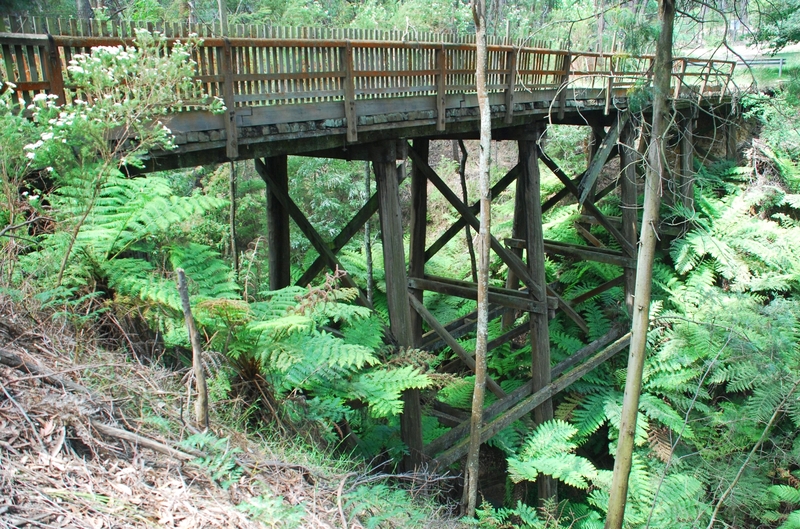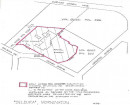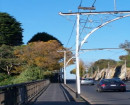TIMBER BRIDGE
BLOOMFIELD ROAD CROSSOVER, BAW BAW SHIRE
-
Add to tour
You must log in to do that.
-
Share
-
Shortlist place
You must log in to do that.
- Download report









Statement of Significance
The Timber Bridge, Crossover was constructed by the Victorian Railways in 1892 as part of the Warragul to Neerim South (later Noojee) line. This railway line was opened as far as Neerim South in the 1890s and was used to transport timber and farm produce. The bridge was designed by Edward Ballard, Chief Engineer of Works for the Victorian Railways. Early roads in the area often followed the ridgelines, whereas the later railway followed creek lines to maintain easier grades. From the summit of Crossover Bloomfield Road follows the ridgeline to the Main Neerim Road. The railway line followed Red Jacket Creek from the south west and intersected the old Bloomfield Road where it crossed the ridge via a deep cutting into the catchment of Red Hill Creek on the north east. The line was closed in 1958 as road transport became more prevalent, and the track has since been removed. Bloomfield Road was later altered with a two lane crossing over the partially filled railway cutting just off the ridge to the north ? the old line of road was then renamed Bridge Road. Vehicular use of the bridge continued for access to properties on Bridge Road until the bridge was recently closed after major failure of a stringer and part of the kerb and railing.
The hill is made of soft material and consequently the cutting is broad with easy angled sides. The Timber Bridge spans around 40 metres with six trestles, the central of which are 15?20m tall. The trestles have two unsquared piles and squared doubled crossheads, doubled walings, and cross braces. There is also paired longitudinal bracing between piles of successive trestles at about one third height . There are five squared 400x180mm stringers to a span. The 175x150mm cross decking is laid diagonally, tarred and overlaid with gravel. A 300x150mm kerb is topped by a timber post and three-rail guardrail, with pickets to the inside similar to those applied to timber foot bridges at stations. The design and detail of the main supporting structure is very similar to that of timber rail bridges built by the Victorian Railways Department, except for the even spacing of the girders across the crossheads.
The Timber Bridgeat Crossover is of scientific and historical significance to the State of Victoria.
The Timber Bridge at Crossover is scientific (technical) significance as an example of a timber trestle road bridge built using the construction methods typicall used on timber rail bridges by the Victorian Railways Department. It differs in detail from the many timber trestle road bridges built in the region by local government, including the use of squared timbers for stringers and the picket style railings.
The Timber Bridge, Crossover is of historical significance as one of the few remaining parts of the infrastructure of the now defunct Warragul to Neerim South line, which was instrumental in the development of the region. The bridge and cutting are of historic significance because they are demonstrative of the successive development of transport routes in the region, with early tracks and roads following the ridges and the later railways taking easier gradients along the creeks andusing cuttings over saddles.
-
-
TIMBER BRIDGE - Permit Exemptions
General Exemptions:General exemptions apply to all places and objects included in the Victorian Heritage Register (VHR). General exemptions have been designed to allow everyday activities, maintenance and changes to your property, which don’t harm its cultural heritage significance, to proceed without the need to obtain approvals under the Heritage Act 2017.Places of worship: In some circumstances, you can alter a place of worship to accommodate religious practices without a permit, but you must notify the Executive Director of Heritage Victoria before you start the works or activities at least 20 business days before the works or activities are to commence.Subdivision/consolidation: Permit exemptions exist for some subdivisions and consolidations. If the subdivision or consolidation is in accordance with a planning permit granted under Part 4 of the Planning and Environment Act 1987 and the application for the planning permit was referred to the Executive Director of Heritage Victoria as a determining referral authority, a permit is not required.Specific exemptions may also apply to your registered place or object. If applicable, these are listed below. Specific exemptions are tailored to the conservation and management needs of an individual registered place or object and set out works and activities that are exempt from the requirements of a permit. Specific exemptions prevail if they conflict with general exemptions. Find out more about heritage permit exemptions here.Specific Exemptions:General Conditions: 1. All exempted alterations are to be planned and carried out in a manner which prevents damage to the fabric of the registered place or object. General Conditions: 2. Should it become apparent during further inspection or the carrying out of alterations that original or previously hidden or inaccessible details of the place or object are revealed which relate to the significance of the place or object, then the exemption covering such alteration shall cease and the Executive Director shall be notified as soon as possible. General Conditions: 3. If there is a conservation policy and plan approved by the Executive Director, all works shall be in accordance with it. General Conditions: 4. Nothing in this declaration prevents the Executive Director from amending or rescinding all or any of the permit exemptions. General Conditions: 5. Nothing in this declaration exempts owners or their agents from the responsibility to seek relevant planning or building permits from the responsible authority where applicable.Exemptions:
* Minor maintenance and repairs which replace like with like.
* Works other than demolition to make the place safe.TIMBER BRIDGE - Permit Exemption Policy
Timber bridges of this type were designed to undergo regular maintenance and replacement of parts. If a bridge of this type and age had had such maintenance, most of the members would already have been replaced at some stage in the life of the structure. Maintenance of this bridges has been neglected for a long period, with resulting failure of major members. If the bridge is to remain standing and useable, urgent replacement of a large number of major members will be required. In the case of such a structure, the preservation of the original fabric is not the primary conservation issue. The ongoing integrity and useability of the bridge is more important, and extensive reconstruction in materials to match the original is acceptable. Major works of this type would be approved by the Executive Director, subject to assessment of a detailed scheme through the permits process. Exemptions are given for minor maintenance and repairs, and for works to make the place safe.
-
-
-
-
-
EDITH INGPEN HOUSE
 Victorian Heritage Register H2416
Victorian Heritage Register H2416 -
FORMER CROSSOVER RAILWAY STATION
 Victorian Heritage Inventory
Victorian Heritage Inventory -
Timber Bridge over Warragul to Noojee Rail
 National Trust H1995
National Trust H1995
-
"1890"
 Yarra City
Yarra City -
'BRAESIDE'
 Boroondara City
Boroondara City -
'ELAINE'
 Boroondara City
Boroondara City
-
-











